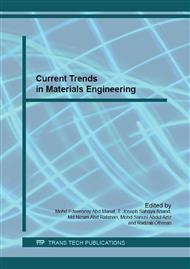p.172
p.179
p.184
p.189
p.195
p.203
p.208
p.213
p.218
Effect of Sonication on the Stability of Nanofluids Based on the Mixture of Kapok Seeds Oil and Multi Walled Carbon Nanotubes
Abstract:
Environmental pollution problem and depletion of petroleum reserves have driven the researchers to use non-edible oils as a low cost feedstock. This work represents the preparation of nano fluids using kapok (ceiba pentandra) seeds oil (KSO) and multi walled carbon nano tubes (MWCNTs). The present study consists of two stages. The first step is the extraction of KSO through Soxhlet extraction using n-hexane as a solvent. The second step is the mixing of extracted oil with carbon nanotubes using sonicator, with different time intervals, to develop nanofluids. The visualization technique was used by capturing photographs to evaluate the stability of the nanofluids. The photographs showed good agreement for the stability of nanofluids for more than 1 week. KSO and prepared nanofluids were characterized by using Fourier transformed infra-red spectroscopy (FTIR) and scanning electron microscopy (SEM).
Info:
Periodical:
Pages:
213-217
Citation:
Online since:
May 2016
Authors:
Keywords:
Price:
Сopyright:
© 2016 Trans Tech Publications Ltd. All Rights Reserved
Share:
Citation:


